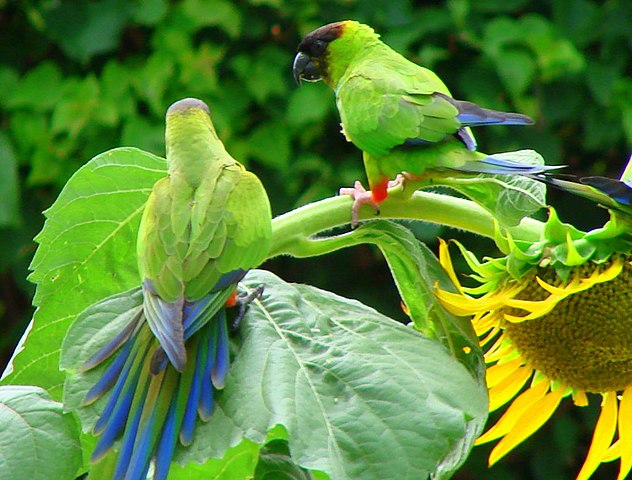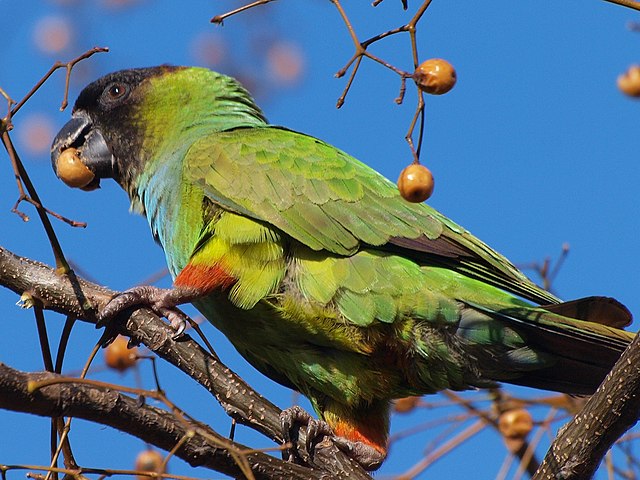The joyful and entertaining Nanday Conure is one of the most entertaining, and fun companion parrots available. They don’t require a daily walk, but they do need a lot of socialization to be happy.
For a person that can supply the love, time, and attention that this parrot species needs, you’ll have found a companion for life.
Nanday Conures are medium size birds that thrive on attention. They have colorful plumage, sporting a black head and a mostly green body. They are acrobatic birds that love to entertain and be entertained by their family.
As such, wherever you decide to house your bird should be in an area that is frequented by other family members. If he is to be housed near the kitchen, be aware that non-stick cookware gives off fumes from the coating that is harmful to birds.

Nanday Conure Cage
The cage for a Nanday Conure should be rather large. A width and height of three feet are good for this twelve-inch bird. Why so big for such a moderate bird? With any bird, Nanday Conure, or tiny little lovebird, the larger the cage the better. They’re birds after all; flight and space are natural to them.
The Nanday Conure specifically, needs to be able to fly around the cage without hitting any of the items inside including the bars. Speaking of bars, they can be spaced as much as half an inch apart to prevent accidents.
Birds like the Nanday Conure need to be stimulated. Their intelligence level demands that they are introduced to new food and toys on a regular basis to prevent boredom. Any toys in the cage are clean and shiny. Beads and bell claspers need to be large and solid to avoid choking hazards. Keeping an extra set of toys on hand eliminates the need to wash the dirty ones right away.
Perches in the cage are to be about nine inches long and no more than half an inch in diameter. Perches can be strategically placed around the cage to give your bird some exercise. If using real wood, be sure to choose untreated tree bark. Platforms in the cage also give your Conure the ability to exercise his feet and avoid arthritis. A lower perch can be used for nail clipping.
A metal cage crate separates him from his waist so he doesn’t play in it or soil his feathers. The openings in the grate should be small enough to keep him from reaching through with his beak and chewing the paper or other medium you place at the bottom of the cage. This is particularly important if you are training your Nanday Conure – highly recommended if you want to prevent behavior problems like biting, screaming, and feather plucking.
When choosing your cage, if you can swing it try to buy a stainless steel cage. The initial cash outset is quite high, however, you won’t ever have to replace it so your return on investment is very good. If you can’t swing a stainless steel cage, the second best option is a steel cage treated with non-toxic and chip-resistant paint.
This is important because many paints contain zinc and other harmful chemicals that will harm your bird when they’re ingested. However, a painted cage is necessary because it will prolong the life of your steel cage.
Cage features are really important too. For example, a cage with a cage door that opens up like a guillotine or upside-down drawbridge can actually kill your Nanday. Instead, look for a cage with a drawbridge door or a door that opens to the side like your household doors. Casters make moving the cage easier and a cover will help your Nanday quiet down at night and get the quality sleep they need.

Nanday Conure Diet
Inside the cage, your Nanday’s food bowls can be small, around a fourth of a cup, or slightly larger. Avoid putting food bowls near the perches so no droppings get added to the main course. Water needs to be free of chemicals (distilled) and both food and water are changed each day. It’s only fresh fare for this handsome guy.
The best diet you can give your Nanday is an organic pellet-based diet. A diet free from chemicals, sugars, and added coloring will help prolong your Nanday’s life. However, a Nanday’s diet requirements are not completely met by a pellet, they need fresh fruits and veggies every single day.
Like you and I, they like variety. Offer fruits and veggies in many forms, raw, cooked, chopped, and pureed, and also many colors. They like dice apples, grapes, pomegranates, and any other orange fruit.
As far as vegetables go, they like green and orange ones. Try broccoli and carrots. Be sure to avoid avocados as they are toxic to all birds. You can also occasionally throw in a bit of cheese or egg for good measure. Seeds and nuts are nice, but since they are high in fat, limit the amount each day to a snack level or reward during your daily training sessions.
